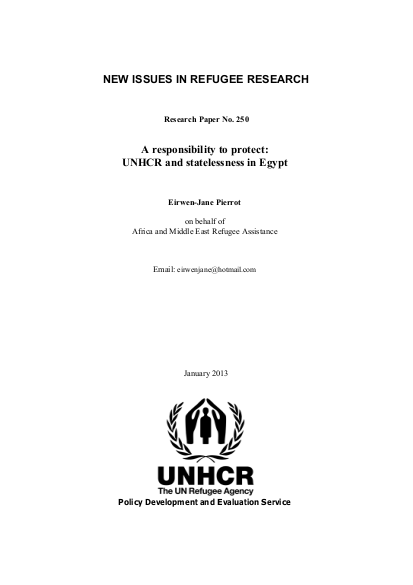
To date there has been no comprehensive research on instances of statelessness in Egypt, which has negatively impacted how government, the United Nations High Commissioner for Refugees (UNHCR), and other organisations have been able to deal with the problem. This paper considers cases of stateless migrants to Egypt and evaluates how far the UNHCR in Cairo as been able to provide stateless persons the international protection they may be owed under the UNHCR’s statelessness mandate.1 This paper aims to be accurate as of March 2012. Since that date, AMERA has worked with UNHCR to address a number of the issues raised, including development of standard operating procedures to determine statelessness in the context of UNHCR's refugee status determination procedures. Egypt is not party to either the 1954 Convention Relating to the Status of Stateless Persons (the 1954 Convention) or the 1961 Convention on the Reduction of Statelessness (the 1961 Convention). Egypt also has no domestic legislation specifically regulating the status of stateless persons. Egypt is, however, party to the 1951 Convention Relating to the Status of Refugees (the 1951 Convention) and the 1969 African Union Convention Governing the Specific Aspects of Refugee Problems in Africa (the 1969 Convention), which both commit Egypt to upholding the basic rights of all refugees, including those who do not hold a nationality. In accordance with an agreement between UNHCR and the Egyptian Government, UNHCR Cairo carries out refugee status determination (RSD) in Egypt. Asylum-seekers awaiting adjudication of their claim and refugees formally recognised under either the 1951 or 1969 Conventions are able to acquire residence permits, renewable every six months, and are protected against refoulement. Case studies demonstrate that stateless migrants who are unable to claim the benefit of the 1951 or 1969 Conventions and who seek protection from UNHCR Cairo for recognition of their basic human rights often do not receive it, despite the organisation’s mandate responsibilities to protect stateless individuals. Stateless persons are often not identified by UNHCR. Even where they are identified the protection afforded to them is at best ad hoc thus leaving many people vulnerable to deportation and detention.
